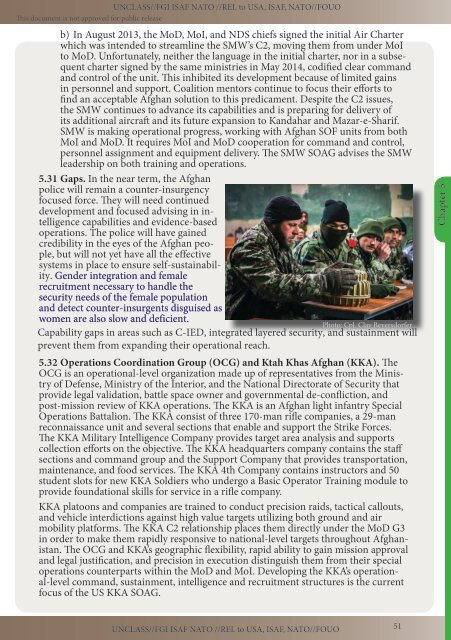20140927_NIU_CJ7_TREX_SFA guide 3.1
20140927_NIU_CJ7_TREX_SFA guide 3.1
20140927_NIU_CJ7_TREX_SFA guide 3.1
You also want an ePaper? Increase the reach of your titles
YUMPU automatically turns print PDFs into web optimized ePapers that Google loves.
UNCLASS//FGI ISAF NATO //REL to USA, ISAF, NATO//FOUO<br />
This document is not approved for public release<br />
b) In August 2013, the MoD, MoI, and NDS chiefs signed the initial Air Charter<br />
which was intended to streamline the SMW’s C2, moving them from under MoI<br />
to MoD. Unfortunately, neither the language in the initial charter, nor in a subsequent<br />
charter signed by the same ministries in May 2014, codified clear command<br />
and control of the unit. This inhibited its development because of limited gains<br />
in personnel and support. Coalition mentors continue to focus their efforts to<br />
find an acceptable Afghan solution to this predicament. Despite the C2 issues,<br />
the SMW continues to advance its capabilities and is preparing for delivery of<br />
its additional aircraft and its future expansion to Kandahar and Mazar-e-Sharif.<br />
SMW is making operational progress, working with Afghan SOF units from both<br />
MoI and MoD. It requires MoI and MoD cooperation for command and control,<br />
personnel assignment and equipment delivery. The SMW SOAG advises the SMW<br />
leadership on both training and operations.<br />
5.31 Gaps. In the near term, the Afghan<br />
police will remain a counter-insurgency<br />
focused force. They will need continued<br />
development and focused advising in intelligence<br />
capabilities and evidence-based<br />
operations. The police will have gained<br />
credibility in the eyes of the Afghan people,<br />
but will not yet have all the effective<br />
systems in place to ensure self-sustainability.<br />
Gender integration and female<br />
recruitment necessary to handle the<br />
security needs of the female population<br />
and detect counter-insurgents disguised as<br />
women are also slow and deficient.<br />
Photo: Cpl. Clay Beyersdorfer<br />
Capability gaps in areas such as C-IED, integrated layered security, and sustainment will<br />
prevent them from expanding their operational reach.<br />
5.32 Operations Coordination Group (OCG) and Ktah Khas Afghan (KKA). The<br />
OCG is an operational-level organization made up of representatives from the Ministry<br />
of Defense, Ministry of the Interior, and the National Directorate of Security that<br />
provide legal validation, battle space owner and governmental de-confliction, and<br />
post-mission review of KKA operations. The KKA is an Afghan light infantry Special<br />
Operations Battalion. The KKA consist of three 170-man rifle companies, a 29-man<br />
reconnaissance unit and several sections that enable and support the Strike Forces.<br />
The KKA Military Intelligence Company provides target area analysis and supports<br />
collection efforts on the objective. The KKA headquarters company contains the staff<br />
sections and command group and the Support Company that provides transportation,<br />
maintenance, and food services. The KKA 4th Company contains instructors and 50<br />
student slots for new KKA Soldiers who undergo a Basic Operator Training module to<br />
provide foundational skills for service in a rifle company.<br />
KKA platoons and companies are trained to conduct precision raids, tactical callouts,<br />
and vehicle interdictions against high value targets utilizing both ground and air<br />
mobility platforms. The KKA C2 relationship places them directly under the MoD G3<br />
in order to make them rapidly responsive to national-level targets throughout Afghanistan.<br />
The OCG and KKA’s geographic flexibility, rapid ability to gain mission approval<br />
and legal justification, and precision in execution distinguish them from their special<br />
operations counterparts within the MoD and MoI. Developing the KKA’s operational-level<br />
command, sustainment, intelligence and recruitment structures is the current<br />
focus of the US KKA SOAG.<br />
Chapter 5<br />
UNCLASS//FGI ISAF NATO //REL to USA, ISAF, NATO//FOUO<br />
51


